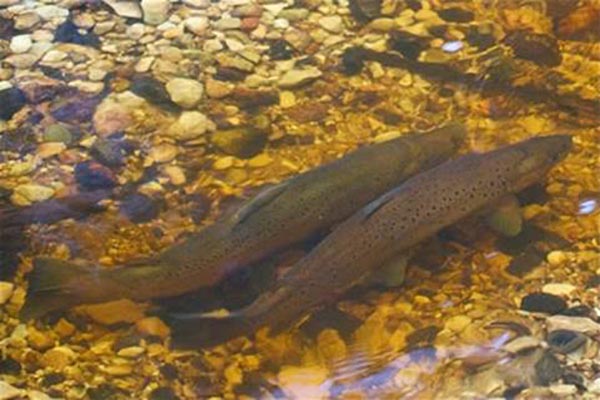There has been a disturbing trend lately of posts, pictures, and mentions of people fishing to spawning trout that are lying on redds and how to do it effectively. The average knucklehead knows how easy it is to catch a trout in the throes of passion. Unfortunately, spawning season is seen by some fishermen as a time to pillage big fish that are seldom seen and even harder to catch.
So what’s the big deal? The big deal is the huge amount of stress placed upon trout as they succumb to the instinct to reproduce. Mother Nature has a unique knack for making reproduction a difficult proposition for many species including the Rainbow and Brown trout. Challenging reproduction assures that only the strongest members of the gene pool are able to pass on their superior traits. The physical toll taken on trout during the spawn is incredible,

often leading to the death of mating fish. Still, there are those anglers who continue to delude themselves by rationalizing their ethics. Hypocritically using “catch-and-release” as their mantra in an attempt to placate their detractors has become the norm in many fishing forum and social media posts.
Imagine piling rocks the size of basketballs into a mound that is six feet tall. Oh, by the way, you have to dig them out of a stream bottom using only your rear end. Remember also that there is a multitude of creatures that want to eat you while you are doing this task in such an exposed fashion. Sounds next to impossible, doesn’t it? Spawning ends up being impossible and deadly in many cases without the help of rapacious anglers. Understanding the motives of fishermen who inhibit reproduction for the very resource that most claim to conserve and protect is easy, combatting them is much more of a quandary.
Rainbows start moving into the shallows as early as the end of February to search for less current and clean gravel to pile into future hatching environs for their eggs. Brown trout are on a reverse schedule, often beginning to dig redds in early October as the water cools in the Autumn. Females do all of the heavy lifting for the most part and the constant scraping and digging takes its toll on their bodies. The most visible injuries are those caused by bacterial and fungal infections. Normally, fish have a layer of protective slime on their bodies. As the female digs and piles rocks, this layer is scraped away. The loss of this protection enables microbes to easily attack the scales and flesh of the fish.
While the ladies are setting up the nursery the guys are busy doing guy things. They muscle up, developing kyped jaws as weapons for use in vicious duels with other males over females and their redds. More importantly, the fierce jaws help protect the redd and his mate from interlopers. Battle scars, bites and scrapes aren’t uncommon in these scraps to determine the genetic hierarchy. Once again infection can find a home in these wounds and it isn’t uncommon to see the aftermath of spawning on a trout’s body for months afterward on both the males and females.
Often just catching a fish in the spawn will cause a release of milt(sperm) or eggs because of the fish’s instinct to reproduce. Situations that stimulate survival instincts will trigger these premature releases of spawn, effectively causing the loss of thousands of eggs or the ability to fertilize. Only 0.5-2% of all hatched eggs make it to adulthood so losing one spawning fish to death or its milt or eggs can have a substantial impact on a fishery.
Imagine the detrimental consequences that just two anglers fishing a spawning bed with 15 redds could possibly have on an entire river. For example, if they catch 20 fish between them with an average weight of 2lbs, two of which eventually die, two prematurely drop their eggs and three squirt their milt. These anglers have effectively prevented the possibility of 11,200 eggs or more from hatching. If you do the simple math figuring a low survival rate of 0.5%, these two anglers will have prevented 56 adult trout from coming into the ecosystem. Imagine if the fish were larger and were laying twice or three times as many eggs how many eventual adult fish would be lost. This is not accounting for the loss of eggs that these two anglers would have destroyed from wading across these “imaginary” redds. Extrapolations and assumptions can easily be made about how much impact that larger numbers of anglers have when fishing to spawning fish on a stream or river system.
Ultimately it comes down to ethics and conscience. Does your ego demand a picture of you holding a large fish be spread across the internet or posted on the local fly shop’s wall? Is this worth possibly killing the trout or destroying its ability to reproduce? Finally; is fishing to spawning trout worth the eventual degradation of the fishery to the point of decreased counts, smaller size and eventual re-regulation? This is your decision to make as an angler and hopefully as a conservationist.


